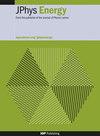Sustainable energy harvesting and breath sensing with electrospun triboelectric nylon-6
IF 6.3
3区 材料科学
Q1 ENERGY & FUELS
引用次数: 0
Abstract
A high-performance triboelectric nanogenerator (TENG) has been developed for breath sensing applications, utilizing tribopositive electrospun nylon-6 nanofibers and tribonegative fluorinated ethylene propylene (FEP). The optimization toward the development of electrospun nylon-6-based TENG includes a range of factors such as the applied force and frequency on tribo responses, the thickness of the fiber mat, the concentration of nylon-6 in the fiber mats, and the selection of the tribonegative material for pairing with nylon-6 nanofiber. Among these parameters, the nanofiber prepared with 18 wt% nylon-6, characterized by a uniform fiber distribution, the highest surface area of 55.69 m2 g−1, and an optimal thickness of 0.169 mm, demonstrated excellent TENG performance, among others. The TENG module constructed using nanofiber in a 4 cm2 area showed the TENG responses of more than 30利用电纺三电尼龙-6 进行可持续能量采集和呼吸传感
利用摩擦正极电纺纳米纤维 6 和摩擦负极氟化乙烯丙烯 (FEP),开发了一种用于呼吸传感应用的高性能三电纳米发电机 (TENG)。开发基于尼龙-6 的电纺 TENG 的优化过程包括一系列因素,例如对摩擦响应的作用力和频率、纤维毡的厚度、纤维毡中尼龙-6 的浓度以及选择与尼龙-6 纳米纤维配对的摩擦阴性材料。在这些参数中,使用 18 wt% 尼龙-6 制备的纳米纤维具有纤维分布均匀、表面积最大(55.69 m2 g-1)和最佳厚度(0.169 mm)等特点,表现出优异的 TENG 性能。在 4 cm2 面积上使用纳米纤维构建的 TENG 模块显示出超过 30 μA 的短路电流、200 V 的开路电压和 90 nC 的手压电荷的 TENG 响应。在 20 MΩ 时,以 10 Hz 频率施加 10 N 的恒定力,可达到 890 mW m-2 的高功率密度。在短短 30 秒内就能将 1 μF 的电容器充电至约 30.1 V,这凸显了电纺尼龙-6 作为纳米发电机能量采集和传感应用材料的潜力。研究发现,TENG 装置足以为 LED 和数字手表显示屏等小型便携式电子设备供电。为了展示其呼吸感应功能,我们制作了一条可穿戴腰带,将其与 FEP 搭配使用。连接到可穿戴腰带中 TENG 的微控制器用于分析呼吸模式产生的输出,随后根据呼吸的性质激活蜂鸣器和 LED。
本文章由计算机程序翻译,如有差异,请以英文原文为准。
求助全文
约1分钟内获得全文
求助全文
来源期刊

Journal of Physics-Energy
Multiple-
CiteScore
10.90
自引率
1.40%
发文量
58
期刊介绍:
The Journal of Physics-Energy is an interdisciplinary and fully open-access publication dedicated to setting the agenda for the identification and dissemination of the most exciting and significant advancements in all realms of energy-related research. Committed to the principles of open science, JPhys Energy is designed to maximize the exchange of knowledge between both established and emerging communities, thereby fostering a collaborative and inclusive environment for the advancement of energy research.
 求助内容:
求助内容: 应助结果提醒方式:
应助结果提醒方式:


